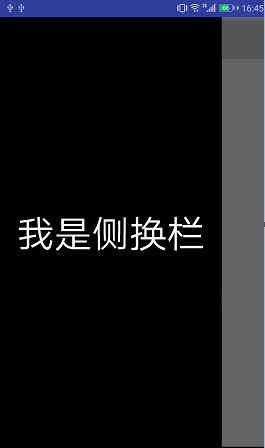详细见:http://www.runoob.com/w3cnote/android-tutorial-drawerlayout.html
布局代码:
<android.support.v4.widget.DrawerLayout xmlns:android="http://schemas.android.com/apk/res/android"
xmlns:tools="http://schemas.android.com/tools"
android:id="@+id/drawer_layout"
android:layout_width="match_parent"
android:layout_height="match_parent">
<FrameLayout
android:id="@+id/ly_content"
android:layout_width="match_parent"
android:layout_height="match_parent">
<TextView
android:layout_width="wrap_content"
android:layout_height="wrap_content"
android:text="主界面"
android:textColor="#000000"
android:textSize="50dp"
android:layout_gravity="center"/>
<Button
android:id="@+id/button"
android:layout_width="match_parent"
android:layout_height="60dp"
android:text="按钮"
android:textSize="30dp"/>
</FrameLayout>
<fragment
android:layout_width="match_parent"
android:layout_height="match_parent"
android:layout_gravity="start"
android:name="com.example.drawerlayout.LeftFragment"
tools:layout="@layout/left_fragment"
android:tag="LEFT"/>
</android.support.v4.widget.DrawerLayout>MainActivity
package com.example.drawerlayout;
import android.support.v4.widget.DrawerLayout;
import android.support.v7.app.AppCompatActivity;
import android.os.Bundle;
import android.view.Gravity;
import android.view.View;
import android.widget.Button;
public class MainActivity extends AppCompatActivity {
private DrawerLayout drawerlayout;
private Button button;
@Override
protected void onCreate(Bundle savedInstanceState) {
super.onCreate(savedInstanceState);
setContentView(R.layout.activity_main);
intiView();
}
private void intiView() {
drawerlayout=(DrawerLayout)findViewById(R.id.drawer_layout);
button=(Button)findViewById(R.id.button);
//drawerlayout.setDrawerLockMode(DrawerLayout.LOCK_MODE_LOCKED_CLOSED,Gravity.START);//设置手势不能打开或者关闭侧滑栏
button.setOnClickListener(new View.OnClickListener() {
@Override
public void onClick(View v) {
drawerlayout.openDrawer(Gravity.START);//设置打开指定侧滑栏
}
});
drawerlayout.addDrawerListener(new DrawerLayout.DrawerListener() {
//抽屉滑动过程中调用的方法
//slideOffset 是(0-1)
/* drawerView 调用drawerView.getTag().equals("START")判断触发菜单事件的是哪个菜单
需要给滑动的侧栏设置 android:tag="LEFT"或者 android:tag="RIGHT"*/
@Override
public void onDrawerSlide(View drawerView, float slideOffset) {
if(drawerView.getTag().equals("START")){
drawerlayout.setDrawerLockMode(DrawerLayout.LOCK_MODE_LOCKED_OPEN,Gravity.START);
}
}
//抽屉打开时,调用的方法
@Override
public void onDrawerOpened(View drawerView) {
}
//抽屉关闭时,调用方法
@Override
public void onDrawerClosed(View drawerView) {
}
/**
* 当抽屉滑动状态改变的时候被调用
* 状态值是STATE_IDLE(闲置--0), STATE_DRAGGING(拖拽的--1), STATE_SETTLING(固定--2)中之一。
* 抽屉打开的时候,点击抽屉,drawer的状态就会变成STATE_DRAGGING,然后变成STATE_IDLE
*/
@Override
public void onDrawerStateChanged(int newState) {
}
});
}
}

